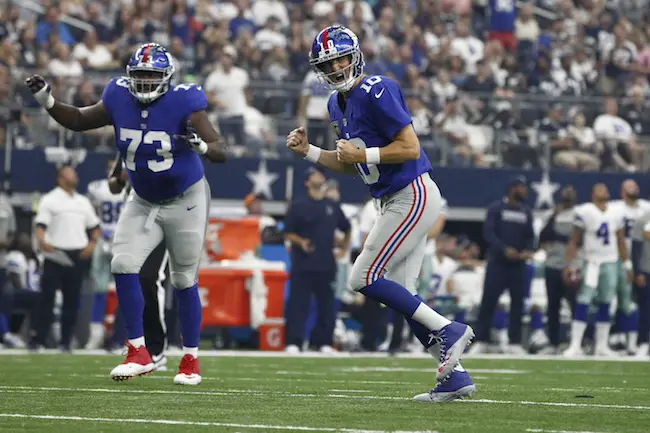
Eli Manning – © USA TODAY Sports Images
[contentblock id=1 img=html.png]
For quarterback Eli Manning and the entire passing offense, 2016 was a major disappointment. The passing game was once again expected to be THE strength of the team. Instead, the New York Giants fell from 7th in the NFL in 2015 (271.4 yards per game) to 17th in 2016 (242.4 yards per game). Manning’s yards, yards per pass play, and touchdowns were down while interceptions increased. All of this was a significant shock given that Manning was coming off of one of his best seasons in 2015 and was entering his third season in Ben McAdoo’s West Coast Offense. The Giants had problems making big plays. And when they didn’t hit the big play, the Giants had problems sustaining drives and scoring points. This wasn’t supposed to happen given return of Victor Cruz and the addition of Sterling Shepard, not to mention the rest of the offense returning mostly intact.
Once again, pundits and fans have begun to question Eli Manning’s future in New York.
THE STARTER
Entering the third season in Ben McAdoo’s West Coast Offense, Eli Manning was expected to build upon his strong 2015 season. Instead, Manning’s production markedly declined in 2016. While Manning nearly tied his career-high completion percentage (63 percent), his touchdown-to-interception ratio fell from 35-to-14 in 2015 to 26-to-16 in 2016. His passing yards (from 4,432 to 4,027), yards per pass play (from 7.2 to 6.7), and QB rating (from 93.6 to 86.0) also dropped. Worse is what happened to the Giants offense as a team. The Giants fell from 8th to 25th in overall offense and from 7th to 17th in passing offense. Manning was the first player selected in the 2004 NFL Draft and immediately traded to the Giants by the Chargers. The 36-year old Manning owns practically every quarterback record in franchise history. He is 8-4 as a playoff quarterback and a two-time Super Bowl MVP. His best season was 2011 when he carried the Giants to the playoffs, highlighted by eight come-from-behind victories. Manning has excellent size and a strong arm. He is extremely tough and has never missed a game in 13 seasons. He only has a 59.7 percent career completion percentage though that figure has improved with the offensive emphasis shifting from a down-field, vertical attack to the West Coast system. Manning has the perfect temperament for playing in the New York metropolitan area as the intense media spotlight does not seem to faze him. He is very smart and hard-working. Manning excels in the mental aspects of the game. Manning reads opposing defenses extremely well. The coaching staff trusts him to make complicated pre-snap reads for both the running and passing games. Manning makes rapid decisions and gets rid of the ball quickly, one of the reasons why his sack numbers are low. On the negative side, Manning is still guilty of making the ill-advised, head-scratching throw when the smarter decision would be to throw the football away or take the sack. His gun-slinger mentality – which leads to big plays – also causes him to make some risky throws in tight windows. A true pocket passer, Manning is not a threat to harm a defense with his feet. Manning was voted to the Pro Bowl in 2008 and 2011, and played in the game after the 2012 and 2015 regular seasons as an alternate. Given Manning’s age and down season, inevitable questions about his current and future ability as a championship-level passer have started again.
THE RESERVES
Ryan Nassib was placed on Injured Reserve in December 2016 with a right elbow injury that required surgery. Nassib was drafted in the 4th round of the 2013 NFL Draft by the Giants. Since 2014, Nassib has been the team’s #2 quarterback. During that time, he has only seen very limited playing time with all of his regular-season throws (10 total) coming at the end of two blowout losses. Nassib has average height, but he is a well-built quarterback with a good arm and decent mobility. He is very smart and played in two pro style offenses in college. At the college level Nassib was a team leader and clutch player who had a history of winning games late. Nassib has not really developed at the pro level and he struggled during the 2016 preseason, completing only 41 percent of his passes with five turnovers (three interceptions and two fumbles).
The Giants signed Josh Johnson in early September 2016 after he was cut by the Baltimore Ravens. He became the team’s #2 quarterback after Ryan Nassib was placed on Injured Reserve in December. Johnson was originally drafted in the 5th round of the 2008 NFL Draft by the Tampa Bay Buccaneers. The well-traveled Johnson has spent time with the Buccaneers (2008–2011), 49ers (2012), Sacramento Mountain Lions (2012), Browns (2012), Bengals (2013), 49ers (2014), Bengals (2015), Jets (2015), Colts (2015), Bills (2015), and Ravens (2016). Johnson has played in 29 regular-season games with five starts – the last coming with Buccaneers in 2011. He has completed 96-of-177 passes (54.2 percent) for 1,042 yards, 5 touchdowns, and 10 interceptions. In the 2016 preseason for the Ravens, Johnson completed 41-of-57 passes (71.9 percent) for 365 yards, 1 touchdown, and no interceptions. He also rushed for 87 yards and 2 touchdowns on 18 carries. Johnson is a mobile quarterback with good size.
PRACTICE SQUAD
Keith Wenning was signed to the Practice Squad in late December 2016. Wenning was originally drafted in the 6th round of the 2014 NFL Draft by the Baltimore Ravens. He has spent time with both the Ravens (2014-2015) and Cincinnati Bengals (2015). Wenning has decent size and a good arm with a quick release. He is not terribly mobile. Wenning is smart, hard-working, and tough.


Sorry, the comment form is closed at this time.